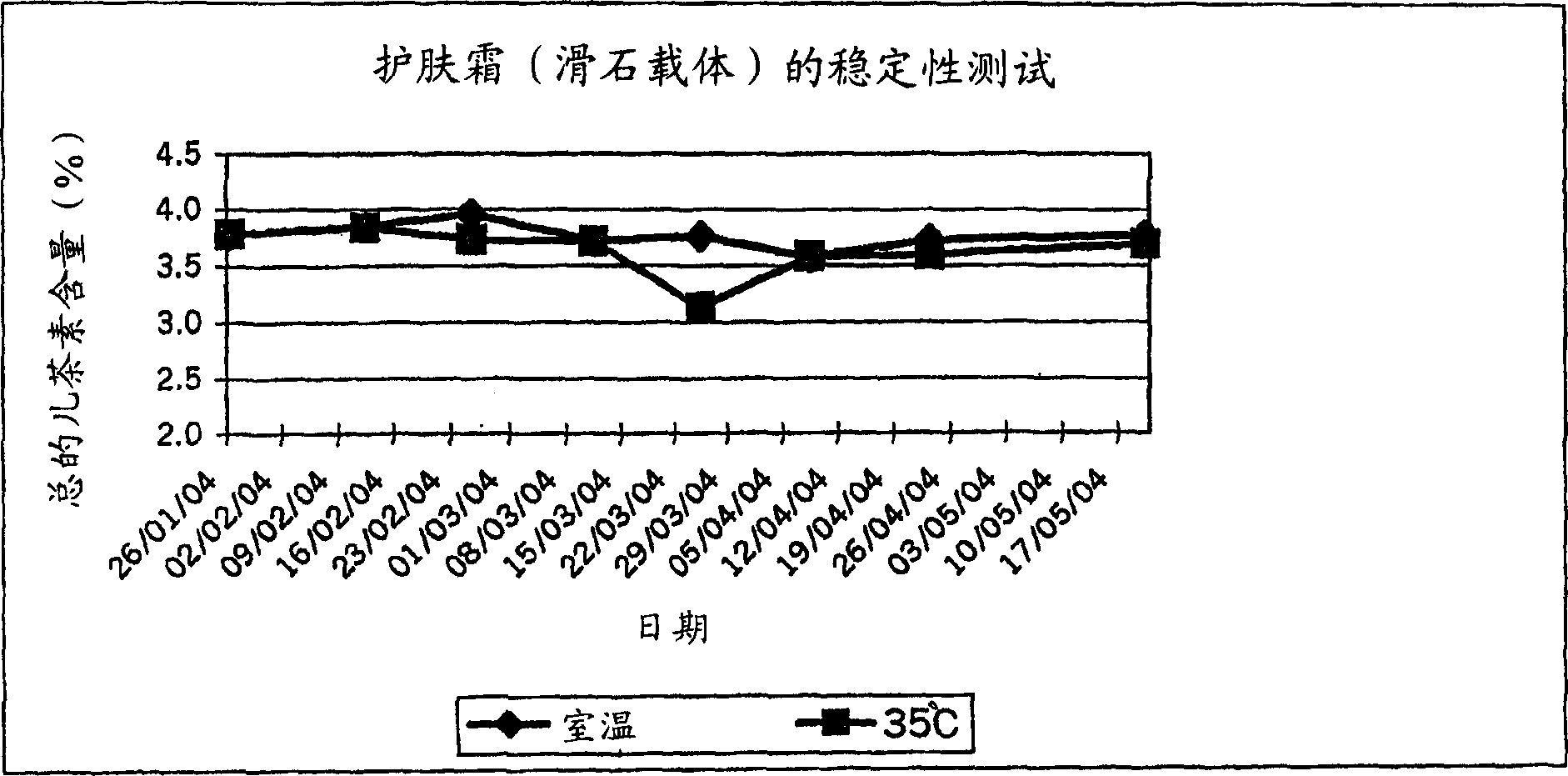Anhydrous topical formulation for polyphenols
A topical preparation technology, applied in the field of anhydrous topical preparations of polyphenols, which can solve the problems of poor solubility of polyphenols
- Summary
- Abstract
- Description
- Claims
- Application Information
AI Technical Summary
Problems solved by technology
Method used
Image
Examples
Embodiment 1
[0015] Example 1: Acne cream (using salicylic acid)
[0016] An anhydrous formulation for the treatment of acne comprising 3% w / w purified green tea extract (containing at least 70% polyphenols) utilizing 0.5% w / w salicylic acid as an appropriate binding carrier was designed as follows:
[0017] 77.1% jojoba oil
[0018] 15.0% beeswax
[0019] 2.0% Lecithin
[0020] 2.0% Ascorbyl Palmitate (Vitamin C)
[0021] 0.2% sorbic acid
[0022] 3.0% Green Tea Polyphenol Extract (70% Polyphenols)
[0023] 0.5% salicylic acid
[0024] 0.2% tea tree oil
[0025] During formulation it is necessary to first pulverize the polyphenols and bound carrier until homogeneous using mild heat and milling. The polyphenol / carrier is then added to the remainder of the dry mixture upon further mixing and / or milling to obtain a uniformly distributed topical mixture.
Embodiment 2
[0026] Example 2: Skin Cream (Using Silicone)
[0027] A formulation for the treatment of damaged skin comprising 5% w / w purified green tea extract (containing at least 70% polyphenols) utilizing 6% w / w micronized silica gel as an appropriate binding carrier was designed as follows:
[0028] 67.5% jojoba oil
[0029] 5.0% dimethyl sulfone
[0030] 12.0% beeswax
[0031] 2.0% Lecithin
[0032] 6.0% silica gel (micronized)
[0033] 5.0% Green Tea Polyphenol Extract (70% Polyphenols)
[0034] 0.2% sorbic acid
[0035] 2.0% Ascorbyl Palmitate (Vitamin C)
[0036] 0.2% lavender oil
[0037] 0.1% tea tree oil
[0038] It is necessary to pulverize the polyphenols and the combined carrier until uniform in the preparation process. The polyphenol / carrier is then added to the remainder of the dry mixture upon further mixing and / or milling to obtain a uniformly distributed topical mixture.
Embodiment 3
[0039] Example 3: Skin Cream (Using Talc)
[0040] A formulation for the treatment of damaged skin comprising 5% w / w purified green tea extract (containing at least 70% polyphenols) utilizing 20% w / w talc as an appropriate binding carrier was designed as follows:
[0041] 58.5% jojoba oil
[0042] 12.0% beeswax
[0043] 2.0% Lecithin
[0044]20.0% talc
[0045] 5.0% Green Tea Polyphenol Extract (70% Polyphenols)
[0046] 0.2% sorbic acid
[0047] 2.0% Ascorbyl Palmitate (Vitamin C)
[0048] 0.2% lavender oil
[0049] 0.1% tea tree oil
[0050] It is necessary to pulverize the polyphenols and the combined carrier until uniform in the preparation process. The polyphenol / carrier is then added to the remainder of the dry mixture upon further mixing and / or milling to obtain a uniformly distributed topical mixture.
PUM
 Login to View More
Login to View More Abstract
Description
Claims
Application Information
 Login to View More
Login to View More - R&D
- Intellectual Property
- Life Sciences
- Materials
- Tech Scout
- Unparalleled Data Quality
- Higher Quality Content
- 60% Fewer Hallucinations
Browse by: Latest US Patents, China's latest patents, Technical Efficacy Thesaurus, Application Domain, Technology Topic, Popular Technical Reports.
© 2025 PatSnap. All rights reserved.Legal|Privacy policy|Modern Slavery Act Transparency Statement|Sitemap|About US| Contact US: help@patsnap.com

